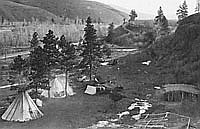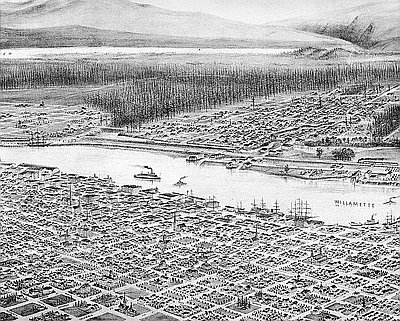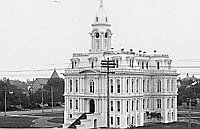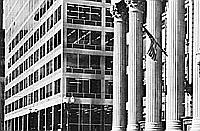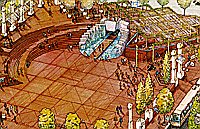Architrave: in Classical architecture, the bottom third of the entablature. The term can also refer to the decorative molding around a window or door: a surround.
Art Deco style: an architectural style derived from a decorative arts term, Art Deco was popular in Oregon from about 1920 to 1940. It features flat roofs, a composition that may be symmetrical or asymmetrical, and decorative elements that are stylized and flowing, with minimal detail. Variant forms include the zigzag moderne, featuring applied designs that resemble lightning bolts or sawblades, and the nautical or streamline moderne, with such features as porthole windows, sweeping curves, and rounded glass brick walls.
Arts and Crafts style: an architectural style found in Oregon between about 1900 and 1920 that derives from an interest in hand-crafted construction and decoration, or what appears to be hand-crafted. Some of the stylistic elements include gable roofs with a very steep pitch, large exterior fireplace chimneys, an asymmetrical design (the sections of the building and the door and window arrangements are irregular rather than balanced), windows that have many small panes, and often a combination of exterior materials that suggest a vernacular style, such as stucco or a simulation of half-timbering.
Bargeboard: an ornamental face board on the gable end of a building that conceals the rafter ends from view
Batten: when exterior wooden boards are used vertically, a thin wooden strip, or batten, is used to cover the exposed seam between the boards. The building is said to have a board-and-batten exterior.
Beaux Arts: the term refers to l’Ecole des Beaux-Arts, the French academic art schooling based on Classical studies. Beaux Arts training emphasized historical Greek and Roman models, and the term often refers to Classical architecture and to the Renaissance revival styles that are based on it.
Bracket: a support—real or decorative—beneath an eave, balcony, or overhang.
Bungalow style: a very popular architectural style used primarily for houses built in Oregon between about 1905 and 1925 that is characterized by a low profile, a low-pitched roof, rectangular composition, and overhanging eaves. Bungalows usually have large porches, and often include a sleeping porch or veranda. While most Oregon bungalows are built of wood, porch supports and fireplaces are often built of cobbles, and brick, especially clinker brick, is also often used.
Castellated: having battlements and turrets that imitate a castle.
Classical architecture: referring to the architecture of ancient Greece and Rome, both of which have well-described structural and stylistic elements and standards of proportion. This historic architectural language has been imitated and adapted in various “revival” styles, and analogies to it are also used by architectural historians to describe more recent developments in architecture.
Clinker brick: originally, malformed bricks; when intentionally created, clinker bricks appear burned and often have slight imperfections to suggest they are rustic and handmade.
Cobble: firm, naturally-rounded rocks used in building or paving. In Oregon, river-washed rocks are often used as cobbles in constructing porch pillars, fireplaces, and foundations, especially in houses in the Bungalow style.
Colonnade: an extended row or façade of columns.
Column: a vertical support, usually round.
Cornice: a decorative projection along the top of a façade; in Classical architecture, the upper part of an entablature.
Craftsman style: an architectural style that in Oregon is essentially synonymous with the Bungalow style. Compare with Arts & Crafts style.
Dentil: a series of decorative small projecting squares or “teeth” that often adorn a cornice or interior molding.
Dormer: a structure that extends outward from a roof, and contains a window. The dormer usually has a gable roof, but it may also be arched.
Eastlake style: An architectural history term referring especially to the “gingerbread” wooden decorative elements that are often found applied to Stick style buildings, as well as to Queen Anne style buildings.
Eave: the edge of a roof that extends beyond the wall of the building
Eave return: a roof edge that makes an acute inward turn for a short distance on the gable end of a building. This is a decorative element of the Greek revival style.
Entablature: a term used in Classical architecture to describe the part of a building supported by columns, termed the cornice, the frieze, and the architrave.
Façade: the main or front face of a building.
Frieze: generally, a horizontal band or strip on a wall or façade; in Classical architecture, the middle part of an entablature.
Gable: the triangular portion of an exterior wall that is formed by the slanted pitch of a ridged roof. A gable roof has a ridge line from which the two sides of the roof extend; the gables are at each end.
Gothic revival style: a style based on medieval church and castle architecture that was popular in Oregon from about 1850 until 1885, and in a second “revival” period in the 1920s. It is characterized by windows with pointed top arches at windows and doors, a steep gable roof, and projecting dormer windows.
Greek revival style: an architectural style popular in Oregon between about 1840 and 1865 that adapted elements of Classical architecture as used in ancient Greece. These include such features as bilateral symmetry (the left and right sides of the façade of the building are identical), porches supported by columns, pilasters at the corners of the building, and a low-pitched gable roof. There is usually a complete entablature.
Half-timbering: a construction method using hewn timbers to frame the building, and filling in the area between the timbers with brick or plaster. The form was imitated in the nineteenth and twentieth centuries, but the timbering and infill plaster or brick were not structural.
International style: a movement that began before World War I that emphasizes function in architectural design and strips decorative elements and traditional stylistic approaches from the architectural vocabulary. It has dominated architecture since about 1950.
Italianate style: an architectural style that was very popular in Oregon, especially for public and commercial buildings, between about 1860 and 1890. Among its characteristics are tall, arched windows (especially noticeable on cast iron front buildings), flat or low-pitched gable roofs, and extensive ornamentation that imitates some of the characteristics of stone construction, such as columns and quoins. The building composition may be symmetrical or not. Other common elements can be heavy eaves or projections, and decorative brackets beneath them, bay windows (extending outward from the building in a projecting bay), and a tower.
Jerkinhead roof: a ridged roof with gable ends, in which the ends are sliced off to give the appearance of a fold or turndown.
Mansard roof: a very steeply sloped, straight, or concave roof that frequently is pierced with projecting dormer windows and sometimes with towers. The mansard roof is a key characteristic of the Second Empire style.
Northwest Regional style: a regional variant of the International style, popular in the Pacific Northwest between 1935 and 1960, that makes extensive use of wood frame construction and unpainted wood finishes, both interior and exterior. The style emphasizes an integration of the building with its setting through asymmetrical floor plans, extensive use of glass extending to the floor, a low-pitched or flat roof of shingles with overhanding eaves, and a minimum of decoration.
Palisade: a wall of vertically-set poles for defense, often pointed at the top.
Pattern book: a published work of architectural plans and drawings from which clients could order detailed instructions for a fee; also used by carpenter builders for design ideas.
Pediment: a decorative triangular cap placed over a door or window.
Pillar: a support similar to a column, but of variable shape, such as rectangular or elephantine (a four-sided pillar that widens toward its base).
Pilasters: a non-structural representation of a column or pillar applied to a flat surface; often used to frame a doorway or mark the corner of a building.
Queen Anne style: an architectural style that was extremely popular in Oregon from about 1880 until 1900. It incorporates many elements of composition: a variety of roof types including large gables and turrets or towers, assorted porches and bay windows, an asymmetrical plan, and windows that are arched or rectangular, pilastered or recessed. Additional wooden decorative elements associated with the Eastlake style are common.
Quoins: distinctive stones set at the corners of a building from top to bottom as reinforcement; in Oregon, wooden quoins imitating those of stone are often a decorative element in buildings built in the Second Empire style.
Renaissance revival style: a term for several “revival” architectural styles common in Oregon between about 1895 and 1925 that make reference to Classical architecture and the Beaux Arts movement.
Revival styles: Throughout the nineteenth and twentieth centuries, architects created styles that were based on historic works from a variety of periods and places. Usually somewhat self-explanatory in their terminology, they include the Classic and Gothic revivals in the mid-ninetieth century and again from the 1910s through the 1930s. Other popular revivals between about 1890 and 1940 include Colonial (referring to the American colonies of the 1700s), Tudor, Jacobethan (a word that combines Jacobean and Elizabethan, the England of ca. 1580-1620), Spanish Colonial or Mission (referring to Spanish California), Pueblo (Southwest American Indian), French and Italian Renaissance, Romanesque, Egyptian, Classical Greek, Classical Roman, and Norman (French) rural. It is not unusual to find aspects of more than one style in a single building.
Richardsonian Romanesque style: an American architectural style designed for stone or brick construction, named for Boston architect H.H. Richardson. Some Oregon commercial, educational and residential buildings were built in this style between about 1885 and 1895. It is associated with an appearance of great mass and weight, round-arched doors and windows, flat roofs, and rough-faced stone. There are often decorative elements that refer to Roman and Byzantine architecture.
Saddle notching: carving a V-shaped notch into logs so that the logs can be stacked horizontally and lock into one another. This was a common method of log cabin construction.
Second Empire style: an architectural style sometimes known as the French mansard style after its most distinctive characteristic, the mansard roof. The name derives from the French second empire of Napoleon III (1851-1870). It is found in Oregon buildings constructed from about 1865 to 1880.
Shingle: a small, thin sawn wooden board, thicker at one end, that is installed with overlapping edges as exterior siding or roofing. It differs from a shake, which has a similar function but is split rather than sawn; a shake is thicker and rougher than a shingle.
Shiplap: horizontal wooden siding that is installed with overlapping edges to shed rainwater; clapboard siding is similar.
Spandrel: the triangular area to the left and right of the top of an arch, if the arch is squared off on the top. The Italianate style, for example, can exhibit many spandrels between the rounded arches of a cast iron colonnade.
Stick style: This Victorian-era architectural style was an American form that originated with wooden buildings, as opposed to being derived from models in stone as were many others of the period. The Stick style emphasizes the vertical, with steeply-pitched roofs and an asymmetrical composition that is often overlaid with wooden decorative elements such as scalloped shingles, geometrically-placed boards, bay windows, and porches with spindles and lattice work. It was popular in Oregon from about 1870 until 1900, especially for residences, but also for schools, hotels, and stores.
Surround: the framing, often decorative, around a window.
Terra cotta: an exterior building material made of clay that has been fired for durability, and is usually glazed. The glazing applies a shine to the surface. Terra cotta is commonly found in white or reddish-brown, but can be found in many colors. It was popular in the construction of steel-framed office buildings, department stores, theaters, churches, and schools from about 1905 until 1940.
Thatched roof: a roof made of bundled straw of reeds known as thatching. An imitation thatched roof was often found in some architectural styles that referred to medieval French or English cottages.
Vernacular style: “Vernacular architecture” is a term used to describe traditional building methods and materials, especially of domestic (houses), agricultural (barns, silos, fences), and industrial structures (mills, factories, warehouses). Carpenters and builders learn the methods by training and observation, rather than through formal schooling, and decoration may be absent or may also be traditional.
© Richard H. Engeman, 2005. Updated by OHP staff, 2014.
